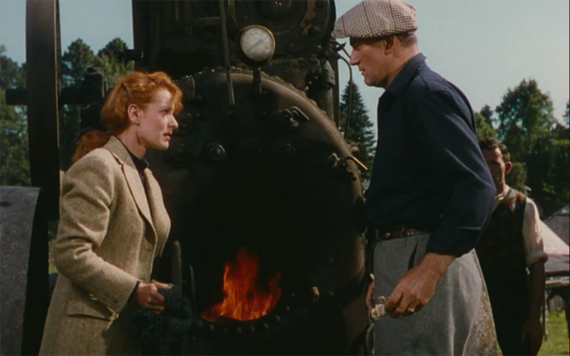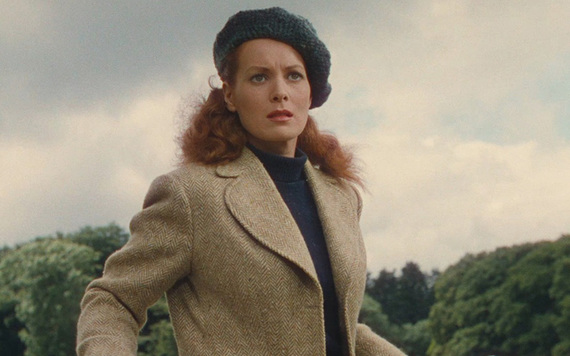The idea of The Quiet Man being a glimpse into an innocent, idyllic Ireland sends shivers up the spine as you see the constant control of the Church in character’s lives.
The Quiet Man, although one of my Dad and Granddad’s all-time favorite films featuring a lifelong hero of theirs John Wayne, has evaded me for 26 years. I know that's something that seems almost sacrilegious to most Irish Americans, but I would wager it's an experience shared by most of us raised in Ireland.
Read More: Does The Quiet Man glorify violence against women and should it matter now?
And so, on this, the 65th anniversary of the release of The Quiet Man, I decided it was finally time for me to get this rite of passage out of the way and settled down to 129 minutes of what I hoped wouldn’t be an overly-leprechaun view of Ireland.
From the opening train scene where the locals are shown to be dithering and nosey, incompetent enough that a train would arrive at its destination four hours late, the stereotypes came fast and furious. The Irish are generally portrayed as a drunken, rural people whose men are always in the pub or betting, and the women are all fiery and bad-tempered or gossips.
Read More: The enduring love of "The Quiet Man"
And the scenes just worsen as a woman’s value is placed only on her ability to have children (constant references to how Mary Kate and Seán should have kids and the widow character being referred to as well-respected even though she “had neither chick nor child”); as female intellect is dismissed (Mrs. Wayfair being told to go to bed and her commenting on her husband, “Poets are so silly, aren’t they?); as Mary Kate is subjected to unwanted compliments from a drunk man and graciously accepting them (the Matchmaker saying he’d marry her himself and she blushes and smiles shyly); and of course, the many times that a much larger Seán uses physical force to express to his wife that he’s unhappy with her.
The Quiet Man portrays a far from innocent Ireland
Acknowledging that The Quiet Man was, of course, first released 65 years ago, there was a point at which I could condemn the sexism and backward portrayal of the Irish people in the movie and move on with my life accepting that it was a different time, different place, different era and while still not unacceptable, it could be remembered as something that should not be replicated in the present or future.
I found myself increasingly gritting my teeth, however, as the many reasons that I could hate this movie as a feminist and an Irish person just kept coming. It wasn’t the actions, scenes, and words themselves that were making me balk, curiously, although they did have me rolling my eyes.

Mary Kate and Seán may seem like a team in the end but they bring out the worst sexist traits in each other.
Read More: Trains will stop at refurbished Quiet Man station once more
However, it is the excuses of those who really love the film that really got to me. The popularly expressed opinion is that this movie showcases some idyllic version of Ireland, an “innocent” time where men were men and women were women. Yet, there is absolutely nothing innocent or aspiring about the Irish society portrayed here and nothing that should lead us to think that we should ever return to it. Have we really moved past the sexism of the 1950s if we still are determined to defend its representation on film because of our own starry-eyed idea that this was the best of Ireland?
The idea of The Quiet Man being “innocent Ireland” reminds me of “Make America Great Again”
Generally, the whole idea of this “innocent Ireland” just reminded me of “Make America Great Again” and I wondered if it is the same Irish Americans who fail to acknowledge that Trump’s idea of America is backward also fail to acknowledge that the Irish society portrayed in The Quiet Man is one to which Ireland should never, ever return.
What on earth could be innocent about a Catholic priest becoming incensed with a woman and telling her it's a sin for her to make her husband sleep in a sleeping bag? More importantly, what was innocent about a system in which Mary Kate was trapped under her brother’s control, only released from his slimy grips by the embarrassment of another woman while, yet again, the priests manipulate the lives of their parishioners?
Read More: John Wayne’s love of Ireland and “The Quiet Man"
What could be so innocent about a culture in which women were also shamed? Take, for example, the slut-shaming scene where the matchmaker calls after Mary Kate, played by Irish actress Maureen O'Hara, to tell her she’s a “hussy” as the loved-up pair evade him to rob a bike and go for a lone cycle. This insult is meant only for her, despite the fact that she is accompanied by Seán Thornton and it was his idea in the first place.
The scenario may seem innocent enough or it may remind you of the systematic way in which Irish women were shamed by their faith, their communities, and even their families and friends for having sex before marriage or becoming pregnant before marriage. This act also involved a man but one for which he would receive none of the blame and punishment. It is within this abuse system that The Quiet Man is set and this should not be forgotten.
Read More: The Quiet Man premiered 65 years ago! Here’s what people thought of it
The alpha Irish male is strongly (and wrongly) celebrated throughout The Quiet Man
And this society is not just unjust to the women. I could almost have felt pity for Mary Kate who never had control over what she could do, was branded a “spinster” as an insult, and had to play along with the foolish customs, if it wasn’t for the fact that she fed directly into the problems of the time, declaring that her husband would only be a real man if he fought her brother and even deciding to leave him because she was ashamed of a man who wouldn’t raise a fist. (It could be argued she's the most sexist character in the movie.)
“What manner of man is it that I have married,” she asks about Seán, her husband, a former boxer who fled America in grief after he killed a man in the ring and is now expected to step up and fight again despite a very obvious trauma. On another occasion, she calls him a “coward,” despite the fact that he’s being brave in standing up for his own principles and choosing not to fight within a community that clearly wants him to throw a punch.
Subtle references do not make The Quiet Man a family movie
Many defenses will declare The Quiet Man a family movie from a better time. Yet could you imagine a movie made today in which a husband picks up his wife and aggressively throws her on the bed and is still classed as a family movie?
It doesn’t make The Quiet Man PG-clean simply because it doesn’t specifically reference the fact that Mary Kate, for much of the latter part of the film, appears to be withholding sex from her husband until she feels he’s proved his manly worth. That may fly over your children’s heads but it certainly doesn’t fly with me as an innocent concept.

Mary Kate may be one of the victims of "The Quiet Man" but she is also one of its most sexist characters.
Read More: Amazing stories about “The Quiet Man” from Maureen O’Hara
As Irish movies go, it’s safe to say that The Quiet Man was far from my top ten, and even if I did want to do for a more diddly-eye version of movie Ireland, I would even brave the banshee in 'Darby O’Gill and the Little People' before turning this on again. God help me, I may even give Leap Year a bash before returning!
That is not to say that The Quiet Man is not an important part of Irish cinema history. As a look at the 1950s, the views on Ireland then, and the way in which men and women were expected to uphold ridiculous gender roles, it will one day, I’m sure, be highly studied and discussed. Let’s just not kid ourselves, however, that it is in any way free from criticism in the role it has played in extending the time of sexist Ireland even further.
Read More: John Ford created Ireland’s lasting image in "The Quiet Man"
What do you think? Is The Quiet Man sexist? Let us know your thoughts in the comments section, below.
* Originally published in Sept 2017.




Comments